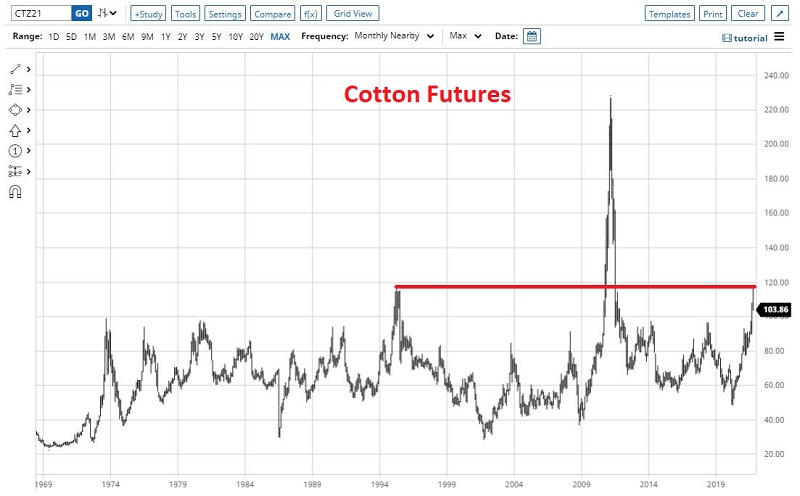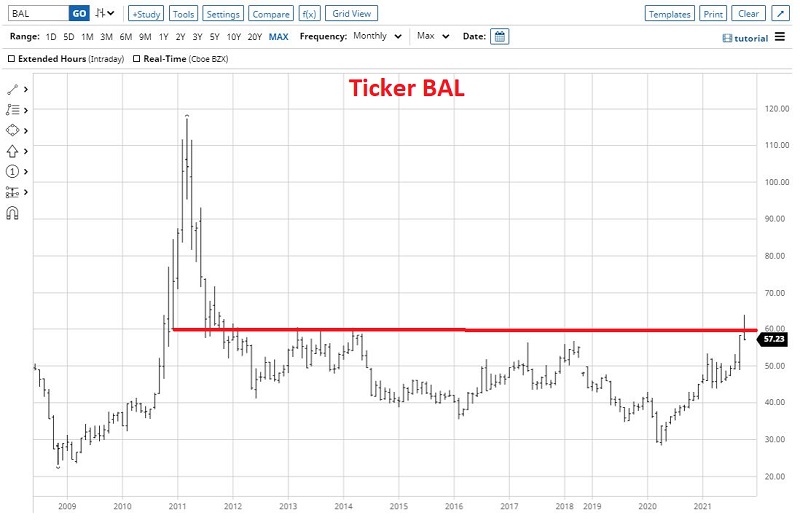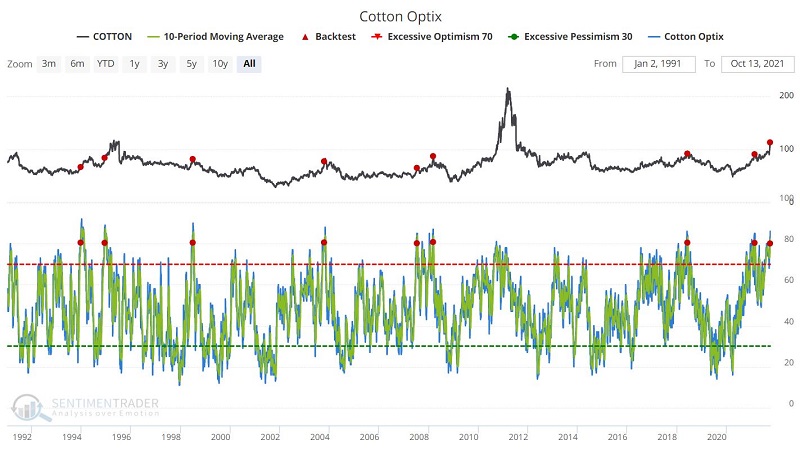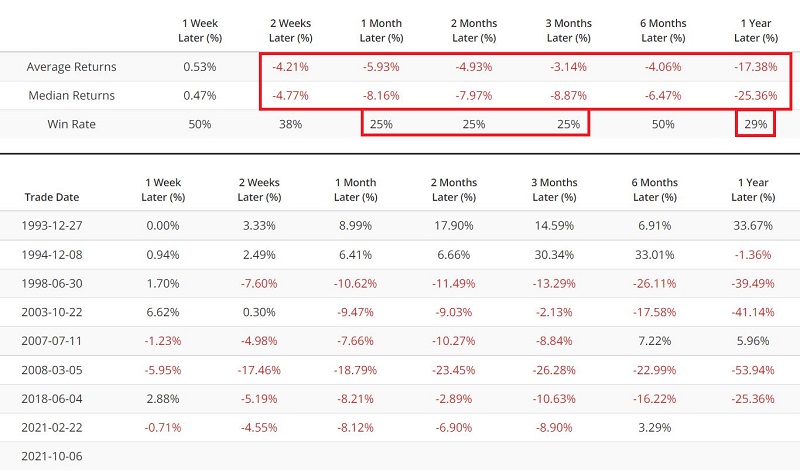About Cotton (and Trading in Volatile Markets)

Although many people use cotton (primarily in the form of clothing), only a handful of people ever "trade" cotton. Still, the topic of "soaring commodity prices" has become a "thing" in the past 12 months (to wit, lumber, crude oil, coffee, natural gas, lithium, uranium, corn, and soybeans, etc.). So, at the very least, more people are likely aware of "soaring cotton prices" than would have even noticed in the past.
And there are valuable trading lessons to be learned from this type of price activity, regardless of the market or stock actually doing "the soaring."
The chart below (courtesy of Barchart.com) displays cotton futures prices since 1969. As you can see, cotton recently soared to its 3rd highest price level ever.
 FYI, non-futures traders can trade the cotton market like trading stocks via ticker BAL (iPath Series B Bloomberg Cotton Subindex Total Return ETN). A chart of BAL appears below.
FYI, non-futures traders can trade the cotton market like trading stocks via ticker BAL (iPath Series B Bloomberg Cotton Subindex Total Return ETN). A chart of BAL appears below.
 Will the red "line in the sand" in the charts above prove to be a formidable resistance level? Or will cotton blow right through and soar to even higher levels? The truth is, I can't tell you. But clearly, there are important implications either way.
Will the red "line in the sand" in the charts above prove to be a formidable resistance level? Or will cotton blow right through and soar to even higher levels? The truth is, I can't tell you. But clearly, there are important implications either way.
HERE'S THE RUB
I am not one to buy into a waterfall decline nor to sell short into a rip-roaring rally. At the same time, I am pretty good at riding a trend that seems to be in force. And I am exceptionally good at remembering that no matter how great a given rally (or decline if I am short) may be, it WILL end someday.
A trader who is making a lot of money fast often tends to forget that part - and to start extrapolating their gains and calculating "how much money I will have by the end next week if the current move continues at its current pace!"
My suggestion is to memorize the following:
Jay's Trading Maxim #18: Follow the trend, but DO NOT fall in love with the trend.
Repeating this simple phrase as often as necessary might one day save you from disaster.
Now back to cotton (or any stock or market that is behaving as cotton has recently).
While the idea of selling short cotton would currently (in my opinion) qualify as a "high risk" proposition in light of the current trend, the reality is that even this trend will not last forever. In fact - as we will see in a moment - history suggests a better than even chance that it won't last long at all. So looking for an opportunity to trade the short side is NOT by itself a mistake
(HINT: The mistake would be trying to pick the exact top and/or NOT taking position sizing and risk management seriously enough).
THE BACKTEST
In the following test of Cotton Optix, we look for those times when:
- The 10-day moving average for Cotton Optix
- Crossed above 80
In a nutshell, we are looking for a sustained period of extreme optimism regarding cotton. The input screens appear below.

 You can run this test by clicking here.
You can run this test by clicking here.
THE RESULTS
The output screen appears in the chart below.

 As you can see in the table above:
As you can see in the table above:
- Overall, the results in the ensuing 12 months have been relatively poor
- BUT each event is its own "roll of the dice"
The bottom line:
- It is OK to believe that cotton may weaken in the months ahead
- It is NOT OK to blindly sell short cotton without implementing proper risk control
Let's talk real-world trading
If you are long cotton (or any tradable that is behaving like cotton is now), there is nothing wrong with "riding the trend." The key to success, however, is to:
- Avoid falling in love with the trend
- Establishing some criteria to tell you WHEN to sell
- Actually selling when your criteria are met (HINT: Easier said than done sometimes)
These criteria can be a trailing stop of a given dollar amount, a break below a given moving average, a double top on a price chart, or just about anything else that is OBJECTIVE.
Remember:
- There is no "one best method" that is always guaranteed to be the optimum choice
- Pick something that makes sense and stick to it!
- And DO NOT beat yourself up if your objective choice proves not to be the optimal choice this time around
The most important thing is to develop your ability to act decisively when the time comes to do so.
On the flip side, if you're planning to play the short-side of cotton (or any tradable behaving like cotton right now), the key - similar to above - is to:
- Establish some objective criteria to tell you when to enter the trade
- Determine your position size (ideally based on some percentage of your account size)
- Determine your maximum dollar risk and where you would need to place a stop to keep your loss to a manageable level
- And finally, make a realistic assessment regarding the viability of the trade given the current volatile nature of the tradable in question
In other words, if your maximum risk threshold is $1,000 and the market in question is moving $2,000 a day, then skipping the trade altogether MAY BE the right thing to do.
The most important thing is to develop your resolve to "stand aside" (or to trade in a very small size) rather than taking on more risk than you can reasonably handle.
Remember, there is always another opportunity coming along. But once you do decide to risk your hard-earned capital, defend it ruthlessly.

